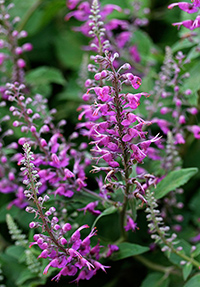Table of Contents
The germander plant is one of many that grow in rocky soils and old walls, adorning them with its soft purple color. Its scientific name comes from Teucrium, a Trojan prince. Many virtues, such as healing gout, were attributed to this plant in ancient times.

The physicians of Charles I, King of Spain, prescribed him germander, but it was unsuccessful. After this incident, the prestige as a panacea declined until the present.
Germander Plant Scientific Facts
- Other names: Wall germander.
- French: Germandree.
- Spanish: Camedrio.
- Environment: European calcareous rocky soils. It has been introduced to America but is not well known.
- Description: The plant of the Labiatae family grows from 10 to 30 cm high. Its stem and the underside of its leaves are hairy. Its flowers are purple and grow along the stem.
- Parts of the plant used medicinally: The flowers and leaves.
Healing Properties and Indications

Germander contains essential oil, tannin, and bitter components. Like all bitters, it stimulates digestion and has cholagogue properties that help to empty the gall bladder. It is used as an appetizer and a stomach tonic. Moreover, it helps eliminate flatulence (excess gas in the digestive tract).
Germander Liquor
Germander is also used in alcohol cold extract (liquors and appetizer wines). However, we do not recommend its use since the evident adverse effects of alcohol overcome the plants.

Marum Germander
Marum germander, also called cat thyme, belongs to the same botanical genus as germander, which it resembles in composition and properties. Though native to Europe, it has been naturalized to warm Central American areas.
It is a digestive and invigorator for asthenia, low blood pressure, and fainting. Its infusion is prepared with 10-15g of plant per liter of water. Drink up to five cups daily.
Frequently Asked Questions
What are the primary health benefits of the germander plant?
The germander plant (Teucrium chamaedrys) has been traditionally used for its medicinal properties. It is primarily known for its anti-inflammatory, antioxidant, and antimicrobial properties.
How does the germander plant benefit the digestive system?
It contains compounds that stimulate the production of digestive enzymes, which can help improve digestion and relieve gastrointestinal discomfort.
Can the germander plant help with respiratory issues?
Yes, germander has expectorant properties, which help relieve respiratory conditions such as coughs and bronchitis. It also helps loosen mucus and facilitate its expulsion from the respiratory tract.
Is the germander plant effective for managing inflammation?
Studies suggest that germander possesses anti-inflammatory properties due to its flavonoid and phenolic compound content. These compounds help reduce inflammation and may offer relief from conditions like arthritis and inflammatory bowel diseases.
What role does the germander plant play in supporting liver health?
The plant’s compounds have hepatoprotective properties, which means they help protect the liver from damage caused by toxins and oxidative stress.
Does germander have any potential cardiovascular benefits?
The plant contains compounds that may help lower blood pressure and cholesterol levels, thus reducing the risk of cardiovascular diseases.
Can germander be used topically for skin conditions?
Yes, germander has been used topically to treat various skin conditions such as eczema, psoriasis, and acne. Its anti-inflammatory and antimicrobial properties can help alleviate symptoms and promote skin healing.
Is germander safe for consumption?
Excessive consumption or prolonged use may lead to liver toxicity. It’s essential to use germander under the guidance of a healthcare professional and adhere to recommended dosages.
Are there any contraindications or precautions associated with germander use?
Due to the lack of safety data, pregnant or breastfeeding women should avoid germander. Individuals with liver disorders or taking medications that affect liver function should also avoid the plant due to its potential hepatotoxicity.
Where can I find germander products and supplements?
Germander products, including teas, extracts, and supplements, can be found in health food stores, online retailers, and through herbal medicine practitioners. Before beginning a new herbal regimen, speaking with a healthcare provider and using only products from trusted companies is essential.
DISCLAIMER: All content on this website is presented solely for educational and informational objectives. It would be best to not rely on the information provided as a replacement for advice, diagnosis, or treatment from a qualified medical expert. If you are pregnant, nursing, or have any preexisting medical concerns, you should talk to your doctor before using any herbal or natural medicines.
REFERENCES
- George D. Pamplona-Roger, M.D. “Encyclopedia of Medicinal Plants.” George D. Pamplona-Roger, M.D. Encyclopedia of Medicinal Plants. Ed. Francesc X. Gelabert. vols. 2 San Fernando de Henares: Editorial Safeliz, 2000. 473. Print. [germander plant]
- Blumenthal, M., Goldberg, A., & Brinckmann, J. (Eds.). (2000). Herbal Medicine: Expanded Commission E Monographs. American Botanical Council.
- Braun, L., & Cohen, M. (2015). Herbs and Natural Supplements, Volume 2: An Evidence-Based Guide. Elsevier Health Sciences.
- Grieve, M. (1971). A Modern Herbal: The Medicinal, Culinary, Cosmetic and Economic Properties, Cultivation and Folk-Lore of Herbs, Grasses, Fungi, Shrubs, & Trees with All Their Modern Scientific Uses. Dover Publications.
- Heinrich, M., Barnes, J., Gibbons, S., & Williamson, E. (Eds.). (2012). Fundamentals of Pharmacognosy and Phytotherapy (2nd ed.). Churchill Livingstone.
- Mills, S., & Bone, K. (2000). Principles and Practice of Phytotherapy: Modern Herbal Medicine. Churchill Livingstone.
- https://pubmed.ncbi.nlm.nih.gov/
- https://www.webmd.com/vitamins/ai/ingredientmono-667/germander
